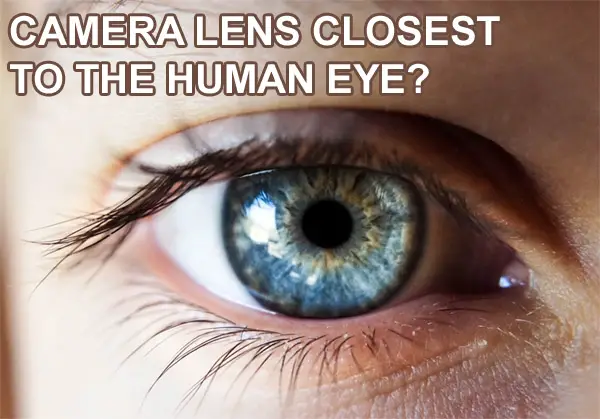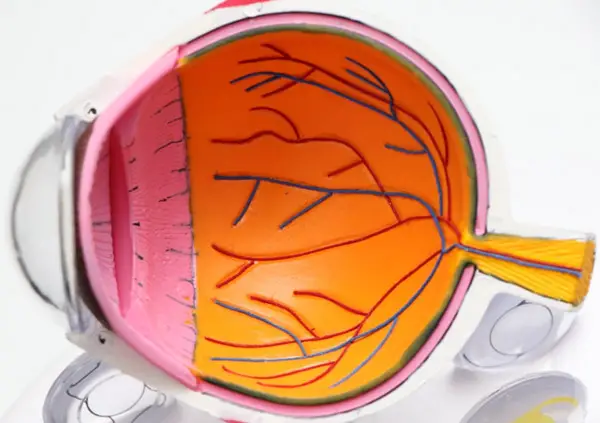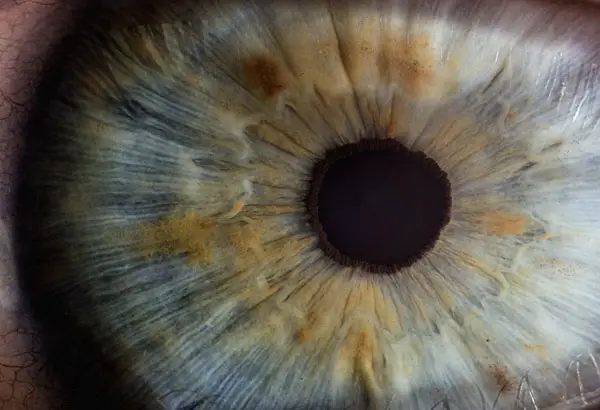The human eye has several camera-like features. As a photographer, you would want to know the various parameters like focal length, aperture, and megapixels of the eye, which are the typical parameters of any digital camera.

Many famous photographers use the eye equivalent focal length to capture most of their images. Why do many photographers prefer to choose this focal length and what camera lens is closest to the human eye?
As a general rule, the lens closest to the human eye is a 50mm prime lens used in video mode mounted on a full frame camera or a 35mm prime lens mounted on a APS-C crop frame camera as only a part of the retina processes the frame the eye sees, and the angle of view of the eye is 55 degrees.
Let’s get into the details and the interesting stuff. Human eyes can view a scene dynamically, whereas a camera is capable of capturing a single picture. The eyes have the ability to focus on places of varying brightness in a scene with appropriate compensation. It is also possible for the eye to focus on the subject continuously with varying distances.
What is the focal length of the human eye?
The focal length of the human eye is the distance between the retina and the eye lens. The focal length of the eye varies from person to person. It is because all people have a different “eye power”.
The typical minimum focal length of the human eye is 22.7 mm (2.27 cm). The typical maximum focal length of the human eye is 25 mm (2.5 cm). Therefore, the nominal focal length of the human eye is generally taken as 22 mm (2.2 cm).
Human eye aperture equivalent?
The maximum aperture of the human eye has been estimated to be anywhere between f/2.1 and f/3.8. Since the human eye is a living organ, the values change over a lifetime (decrease) and also depend on any conditions such as diseases of the eyes. These values are equivalent to pretty fast camera lenses (think f/1.8 and f/2.8). The minimum aperture on the other hand for the human eye is in the range of f/8 to f/11, which may be why we need sunglasses on bright days.
The function of the human eye is more or less similar to the function of a camera system, including the aperture. Let us have a look at the workings of the human eye.
The eye gives us a sense of sight. The human eye consists of an eyeball that is spherical in shape. The diameter of the eyeball of a typical human eye is approximately 2.5 cm. There will be a small bulge in the front of the eyeball, and that is referred to as the cornea.

The iris is behind this cornea. The pupil is the colored section with a hole in the middle. The amount of light that goes inside the eyeball is regulated by the pupil. The opening and closing of the pupil is facilitated by the circular tissues found in the iris.
The focusing on the subject is done with the help of the eye lens and the cornea. The focusing by the eye is done through the light-bending phenomenon. The light rays coming from the object pass through the cornea. The bending of the light happens at the curvature. The curvature of the eye lens is adjusted so that the subject gets focused on properly.
Is the focal length of the eye lens fixed?
It is not possible to change the distance between the eye lens and the retina of the human eye. The human eye has the ability to see both nearby objects as well as far objects clearly. The power of accommodation of the human eye makes it possible. The process by which the human eyes change the optical power of the eye to maintain a clear focus on the subject when the distance is varying is called accommodation of the eye.
It is possible to vary the focal length of the human eye. The focal length variation is possible with the help of the curvature. The ciliary muscles inside the eye hold the eye lens. Thus, the focal length variation is possible to an extent with the use of these ciliary muscles.
What is the far point of the human eye?
The far point of the human eye is the most distant point at which the object can be placed at the optical axis of the eye and can be focused. In other words, it is the farthest point where the subjects appear clear to the human eye.
For a normal human eye, the far point is infinity. This distance is generally defined as 6m or 20 feet. It is because the change of accommodation is negligible between 6m and infinity.
If the human eye is myopic or hypermetropic, then the far point will be different. If it is a myopic eye, it will be closer than 20 feet. Here, the far point is decided by the refractive error of the eye. If the eye is a hypermetropic one, the focus point will not occur on the retina. Instead, it will be behind the retina.
The far point of the human eye is also expressed in diopters. For example, if the far point of a person is 200 cm, then in diopters, it will be 0.5 diopters (1/2m).
What changes the focal length of the eyes?
Whenever the focal length of the eye changes, it indicates a change in curvature of the eye lens. This change is mainly attributed to the ciliary muscle action. The shift in the curvature of the eye lens happens due to the contraction and relaxation of the ciliary muscles. It is this ability of the eye lens to vary the focal length that makes it possible for the eye to see near and far subjects properly.
Camera lens focal length closest to the human eye?
By now you know that the function of the human eye has a very close resemblance to a camera system. The question is, which lens focal length corresponds to the human eye? The 50 mm lens is the camera lens that most closely matches the human eye. The angle of view created by the 50 mm focal length is almost the same as the human eye’s viewing angle. The angle of view is determined by the focal length of the eye.
The 50 mm prime lens, popularly known as the nifty fifty lens, is also called the normal or standard lens. Almost all types of photographers will have one 50mm lens in their kit. It is mainly due to the fact that the perspective of this focal length is similar to the perspective of the human eye. For example, the famous photographer Henri Cartier Bresson has captured many mind-blowing frames using the 50 mm lens. It was one of his favorite lenses.
Keep in mind that you need to use the 50 mm lens with a full-frame camera body to get the human eye’s angle of view. But, if you are using an APS-C camera body, then the focal length of the lens needs to be different. It is because crop-frame camera bodies introduce a crop factor. So, the effective focal length will be more. So, you need to use a 35mm lens with an APS-C camera body to get the human eye’s focal length. The size of the camera sensor needs to be considered while calculating the effective focal length.
If you remember, I have mentioned 22.7mm and 25 mm as the minimum and maximum focal lengths of the human eye. So, how does it change to 35mm on an APS-C camera body and 50mm on a full-frame camera body? It is due to the fact that the angle of view of the human eye is not defined by these minimum and maximum focal lengths. Only a part of the retina processes the frame that the eye sees. The rest of what the eye sees is called peripheral vision.
Many studies have been conducted to find the exact angle of view of the human eye. Based on these studies, the value was found to be 55 degrees. If you consider the full-frame camera, then the 50 mm will not correspond to the exact angle of view. It is only an approximate value. The exact value is 43 mm.
How many megapixels is the human eye?
According to Dr. Roger Clark, who is a photographer as well as a mathematician, the resolution of the human eye is 576 megapixels. He has derived this value based on lots of mathematical calculations. When you compare this resolution with the smartphone or DSLR camera resolution, it is pretty huge.
According to Roger Clark, the functioning of the human eye is more comparable to a video camera than a single frame camera. Unlike a camera, the human eye cannot take individual snapshots and save them in your memory. Thus, the megapixel resolution of the eye does not make much sense.
What is the ISO range of the human eye?
Now, you might be thinking what would be the ISO range of the human eye. This question is a little tricky. If you compare the human eye with the camera sensor and film, there is no base ISO level.
The eye has the unique ability to adjust to different lighting conditions. It can easily handle a dim light condition as well as an extremely bright light condition. If it is a low light condition, then the ISO value of the human eye is said to be 800. If it is a sunny daylight condition, then the ISO value of the eye is 1.
The human eye is capable of detecting contrast ranges in excess of 10,000 to one. No digital camera or film camera can match this.
What would be the shutter speed range that the human eye can handle?
A typical human eye can easily handle a light flash as fast as 1/100th of a second. If the lighting is pretty good, then it is possible to handle light flashes 1/200th of a second or less. The shutter speed value will mainly depend on the age and health of the person.
What is meant by the blindspot of the eye?
A blindspot will be present for both of our eyes. There is a group of nerve cells in our eyes known as photoreceptors. They are present in the rear inner lining of our eyes. The light falling on these photoreceptors gets converted to electrical impulses. These electrical impulses are passed on to the brain for processing.

These photoreceptors will be bundled together at a spot, before they head towards the brain. This spot is referred to as the optic nerve head. There won’t be any photoreceptors at this spot, and it is referred to as the blind spot in the eye.
What is the dynamic range of the human eye?
When you compare the dynamic range of any camera with that of the human eye, then you can really say that the human eye has got a very high dynamic range.
Our eyes are said to have a dynamic range that exceeds 24 stops. This dynamic range is calculated based on multiple situations where the pupil of the eye closes and opens for different brightnesses. Here, the adjustment of the eye cannot be compared with a still camera. It is closer to a video camera.
So we need to make the comparison based on the instantaneous dynamic range. The opening of the pupil must remain unchanged. In such a situation, the camera will perform better than the human eye. Based on the instantaneous dynamic range factor, the eyes have got 10 to 14 f-stops of dynamic range. This range will surely surpass all the point and shoot digital cameras. It is more or less similar to that of DSLR and mirrorless cameras.
Contrast and brightness are the two main parameters that decide the dynamic range of the eye. So, the dynamic range of 10-14 f-stops is applicable only in daylight conditions. On the other hand, if it is in a low light situation, then our eyes will have more dynamic range than the camera.
If it is an extreme low light situation, such as a moonlit scene, then our eyes will start seeing things in monochrome. If you are into astrophotography, then you will find this information very useful.
Actual lenses similar to the human eye
Let’s look at some lenses then which would be closest to the human eye. As we said, on a full frame camera, this would be a 50mm prime lens with a maximum aperture between f/2.1 and f/3.8.
Those are similar to the specs of the Nikon AF-S Nikkor 50mm f/1.8G Lens or the Canon EF 50mm f/1.8 STM Lens.
On an APS-C camera, it would be a 35mm lens with an aperture between f/2.1 and f/3.8 such as the Nikon AF-S NIKKOR 35mm f/1.8G ED or the Canon EF 35mm f/2 IS USM.
You can watch this video from Interesting Engineering to learn the similarities between the human eye and the digital camera:
You can also consider reading this article on improving your photographic eye to create some unique images.
I hope this article has been as interesting to read as it was to write. It is pretty amazing that we see the world with the equivalent of two camera lenses.








